
|
You entered: ice
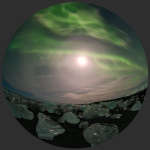 Aurora on Ice
Aurora on Ice
12.02.2015
Not from a snowglobe, this expansive fisheye view of ice and sky was captured on February 1, from Jökulsárlón Beach, southeast Iceland, planet Earth. Chunks of glacial ice on the black sand beach glisten in the light of a nearly full moon surrounded by a shining halo.
 Europa: Ice Line
Europa: Ice Line
18.04.2000
This bright white swath cutting across the surface of icy Jovian moon Europa is known as Agenor Linea. In all about 1000 kilometers long and 5 kilometers wide, only a section is pictured here as part of a combined color and black and white image based on data from the Galileo spacecraft.
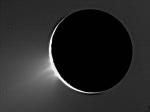 Ice Fountains Discovered on Saturns Enceladus
Ice Fountains Discovered on Saturns Enceladus
5.12.2005
Fountains of ice shoot out from Saturn's moon Enceladus. Clear discovery images of the fountains were made using observations from the robot Cassini spacecraft currently orbiting Saturn. During a recent pass, Cassini was programmed to look back toward the Sun where Enceladus would appear as a thin crescent.
 Ice Fishing for Cosmic Neutrinos
Ice Fishing for Cosmic Neutrinos
3.08.2003
Scientists are melting holes in the bottom of the world. In fact, several holes have been melted near the South Pole, and they are now being used as astronomical observatories. Astronomers with the Antarctic Muon and Neutrino Detector Array (AMANDA) lower into each vertical lake a string knotted with basketball-sized light detectors.
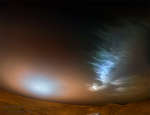 APOD: 2024 December 3 Б Ice Clouds over a Red Planet
APOD: 2024 December 3 Б Ice Clouds over a Red Planet
3.12.2024
If you could stand on Mars -- what might you see? You might look out over a vast orange landscape covered with rocks under a dusty orange sky, with a blue-tinted Sun setting over the horizon, and odd-shaped water clouds hovering high overhead.
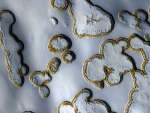 Dry Ice Pits on Mars
Dry Ice Pits on Mars
26.09.2011
Part of Mars is defrosting. Around the South Pole of Mars, toward the end of every Martian summer, the warm weather causes a section of the vast carbon-dioxide ice cap to evaporate. Pits begin to appear and expand where the carbon dioxide dry ice sublimates directly into gas.
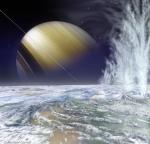 Enceladus Ice Volcanos
Enceladus Ice Volcanos
8.06.2006
In this stunning Saturnian vista - one in a series of artist's visions of volcanos on alien worlds - icy geysers erupt along narrow fractures in inner moon Enceladus. The majestic plumes were actually discovered by instruments on the Cassini Spacecraft during close encounters with bright and shiny Enceladus last year.
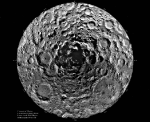 Ice at the Lunar South Pole
Ice at the Lunar South Pole
4.12.1996
Ice on the Moon? The prospecting Clementine spacecraft may well have discovered it. In 1994, Clementine spent 70 days in lunar orbit mapping the Moon's surface. Shown above is a dramatically detailed composite view centered on the Lunar South Pole - constructed from 1500 Clementine images.
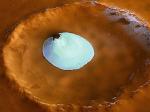 Water Ice in a Maritan Crater
Water Ice in a Maritan Crater
20.07.2005
What lies on the floor of this Martian crater? A frozen patch of water ice. The robotic Mars Express spacecraft took the above image in early February. The ice pocket was found in a 35-kilometer wide crater that resides 70 degrees north of the Martian equator.
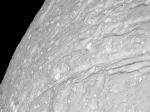 Cratered Cliffs of Ice on Saturns Tethys
Cratered Cliffs of Ice on Saturns Tethys
12.10.2005
The surface of Saturn's moon Tethys is riddled with icy cliffs and craters. The most detailed images ever taken of Tethys were captured late last month as the robot Cassini spacecraft swooped past the frozen ice moon.
|
January February March April May June July |
|||||||||||||||||||||||||||||||||||||||||||||||||